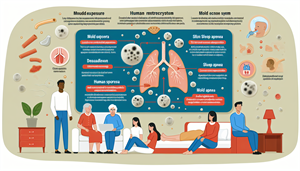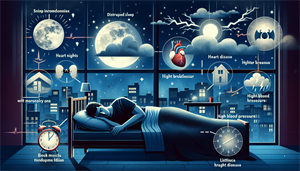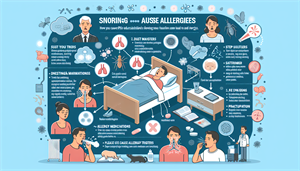
Can Mold Cause Sleep Apnea?
If you’re wondering whether mold in your environment can lead to sleep apnea, you’re not alone. In fact, the question “can mold cause sleep apnea?” is quite common. Mold exposure can cause inflammation and nasal congestion, which are known factors in sleep disturbances and may contribute to obstructive sleep apnea. This article explores the evidence and explains how mold relates to sleep problems, including the possible link to sleep apnea and answering the question, can mold cause sleep apnea?
Key Takeaways
Exposure to mold can lead to obstructive sleep apnea and other sleep disturbances due to induced inflammation, nasal congestion, and respiratory issues such as chronic bronchitis and asthma. Molds present in sleeping environments can damage health and property, and may not always be visible, requiring meticulous inspection and proper removal techniques to identify and mitigate. Research has established a clear correlation between exposure to dampness and mold and the onset of various sleep disturbances, suggesting the importance of maintaining dry, mold-free living and working spaces for better sleep quality.
Unveiling the Connection: Mold and Obstructive Sleep Apnea
The quality of your sleep can be significantly affected by mold exposure. As you breathe in mold spores, it results in nasal congestion which in turn leads to breathing difficulties, a prominent factor in sleep apnea and disturbed sleep patterns. Moreover, mold exposure can potentially lead to the development of sleep apnea or hypopnea by inducing inflammation in the upper airway. This inflammation obstructs breathing during sleep, further deteriorating sleep quality. Worsening of these conditions can also occur when exposed to -1,3-glucan, a primary component of mold cell walls, as it contributes to baseline and chronic bronchitis symptoms.
The Role of Allergic Rhinitis
Allergic rhinitis, also known as hay fever, is a common health issue that can be triggered by exposure to indoor molds like Alternaria and Cladosporium. This condition often leads to adult allergic symptoms, such as: Nasal congestion, irritation, sneezing, runny nose, itchy or watery eyes, itchy throat or ears, coughing, and fatigue. These insomnia symptoms can cause difficulty maintaining sleep and make daily activities uncomfortable. Both the duration and quality of sleep can be significantly impacted by work induce sleep disturbances, potentially resulting in sleep-disordered breathing patterns such as obstructive sleep apnea.
Chronic Sinusitis and Its Impact
Chronic sinusitis, often linked to mold exposure, is another condition that can negatively affect sleep. It involves inflammation in the sinus tissues, which can obstruct the nasal passages and disrupt normal airflow. This obstruction can lead to breathing difficulties during sleep, a significant factor in the development of obstructive sleep apnea. There is a documented association between mold exposure and the development of chronic sinusitis, although the specific prevalence among affected individuals has not been definitively established.
How Mold-Related Respiratory Issues Affect Sleep Quality
Respiratory problems associated with mold exposure, such as asthma and chronic bronchitis, can have a detrimental effect on sleep quality. For example, 6.5% of participants in a study had chronic bronchitis, and 7.9% had doctor-diagnosed asthma, conditions that can be exacerbated by mold exposure. These respiratory problems can disrupt regular breathing patterns during sleep, potentially contributing to the onset of sleep apnea.
Identifying Mold in Your Sleeping Environment
Preventing potential harm to both health and property is crucial and this can be achieved by detecting mold in your bedroom. Indications of mold growth may include visible growth in corners or behind furniture, but it can also hide behind wallpaper, paneling, carpet, and other materials. Regular inspection and proper removal techniques are essential to maintain a mold-free sleeping environment.


